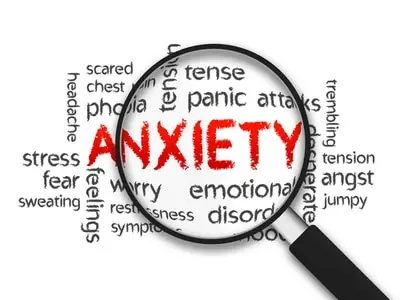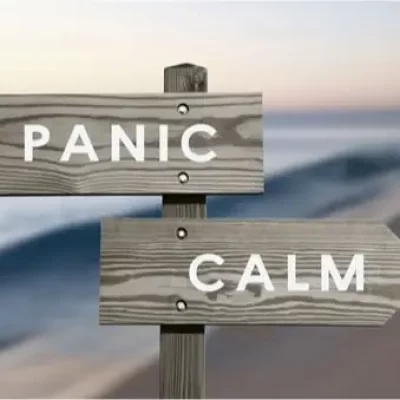Today we will be addressing all things regarding panic attacks including ways to push through these seemingly, terrifying moments. We will talk about:
- What is a panic attack?
- What a panic attack feels like
- Recognizing panic symptoms
- Panic Chest Pains
- Derealization, depersonalization, and other experiences
- Documenting panic as it happens
- Anxiety and panic in men and women
- 3 tips to curb your panic attacks
- Getting yourself to a place where you’re experiencing panic attacks less frequently.
What is a panic attack?
Panic attacks are sudden and involve intense and often overwhelming fear. They’re accompanied by frightening physical symptoms, such as a racing heartbeat, shortness of breath, or nausea.
What a panic attack feels like
Everyone experiences panic attack symptoms differently but the one consensus that we’ve heard as therapists over the years is that it is a horrible experience draining all of your energy. Some people feel as though they can’t breathe. Others experience feelings similar to that of a heart attack. All feel a sense of being out of control, whether it be of the mind, body, or situation.
You may physically experience:

- Rapid, pounding heart rate
- Chest pain
- Cold Sweats
- Trembling
- Hyperventilating
- Shortness of breath or tightness in your throat
- Hot flashes
- Nausea
- Abdominal cramping
- Headache
- Dizziness, lightheaded or faintness
- Numbness or tingling sensation
Mentally you may experience:
- Feeling of unreality or detachment
- Sense of impending doom or danger
- Fear of loss of control or death
It doesn’t matter how long you’ve been experiencing intense panic attacks or anxiety for. It is always very emotionally distressing and you can feel the side effects from it hours and sometimes even days afterwards.
Recognizing panic symptoms
Like most things in mental healthcare, everyone experiences panic attacks differently. Please do keep this in mind.
It’s important to recognize what your panic attack symptoms are. When they start to occur you will have a level of mindfulness that tells you this is what’s going on. At this point, you can start to implement techniques to reduce your panic attacks and help reduce your stress levels.
Panic Chest Pains
Panic chest pains are most frightening. However, it is quite common. It is crucial to recognize this particular symptom as it also tends to carry a hefty price tag.
Often people go to the ER with chest pain believing they are having a heart attack, but the reality is they’re having a panic attack. Being aware of such symptoms will help keep you calm and in the know with your body.
Derealization, depersonalization, and other experiences
There are panic attack symptoms formerly referred to as derealization and depersonalization. It is a fancy way of saying you don’t feel like what is around you is real and you do not feel like yourself.
You might feel like you are having an out-of-body experience or that your current reality isn’t real. This can be extremely stressful for anyone, but especially if you are already at a heightened level of anxiety.
You may be simultaneously experiencing excessive sweating, an intense fear of losing control, fear of choking, or abdominal pain or nausea. You can have shortness of breath or you slight trembling to moderate shaking.
Documenting Panic As It Happens
Now, we know everyone experiences these symptoms differently. I would highly suggest for you to document what specific symptoms you typically experience when you have a panic attack.
Whenever panic does come on you will not be as shocked. You can say to yourself, “OK this is a panic attack and now I’m feeling this way so let me do some of these other things to start feeling better”.
Anxiety vs panic
Anxiety is the most common mental health disorder in the United States. It is the home in which panic lives. However panic attacks are not recognized in the DSM-5.

Panic attacks are a severe and sudden onset of anxiety, expected or unexpected, triggering multiple physical and mental responses.
Anxiety and panic do often carry the same symptoms and are frequently used interchangeably.
Anxiety affects women about two times more often than it does men. Most experts will recommend regular anxiety screenings to females over age 13 years because women are at a much higher risk for developing panic.
3 tips to curb your panic attack
If you suffer from panic attacks there is some good news. It is treatable. There are different things you can do to reduce your symptoms and cut down the frequency and intensity.
- The number one thing is to go to a therapist. You can see a provider virtually or in person, but they should be vetted. You will want them to be highly rated and trained in evidence-based practices. Typically with panic attacks, cognitive behavioral therapy is the best treatment that you can do. It’s backed by research. So, essentially if you do go to therapy and you do the things that your counselor talks to you about and learn about panic disorder there’s a really high likelihood that your symptoms will decrease and you will start to feel better.
- The second tip is diaphragmatic breathing. It can never be stressed enough. It is so important. I feel like a broken record sometimes, because I talk about breathing quite a bit but there’s a reason why. It’s because it works and it’s free. You don’t have to pay for anything, you don’t need a prescription for it, and you’re going to breathe nevertheless so you might as well work on improving. Your breathing will help you relax. When you start to get stressed out you might not consciously realize it but you actually start to hyperventilate or breathe in more frequently occurring shallow breaths. When you start to hyperventilate this actually increases your blood pressure and causes your body to release cortisol. This puts you in that ‘fight or flight’ mode. Improving your breathing can help to prevent panic attacks and to cope with the terrifying “next one” before it starts. Diaphragmatic breathing is a wonderful type of breathing that you can incorporate into your day or in your lifestyle. In general, to help you stay calm and to help you to reduce your anxiety and panic whenever those symptoms do come about.
- There’s also visualization which is a wonderful tool to use. Again, you can use this anytime you don’t need to pay to visualize. That’s why we love it so much. So, essentially you are “Going to your happy place”. Consider what places, people or the environment around you that makes you the most happy. And for everyone it’s different. Some might say it’s laying out on the beach in an exotic foreign country and others might say it is simpler that that. It might even be a sporting event. Just close your eyes and envision that you are wherever it is that makes you feel good. Spend a lot of time, do your deep breathing while you are visualizing this and this will help to reduce your stress. Ideally you want to visualize something that is relaxing, but again it’s your perception.
If you have a hard time with visualizing or feel you don’t have the best imagination, you can go to Youtube and search “guided visualization meditation”. Here you will find many different options to choose from.
Getting yourself to a place where you’re experiencing panic attacks less frequently.
In the midst of an attack, you’re terrified and once it’s over you’re terrified of the next one. It can be an excruciating cycle. Reaching out to a qualified therapist for help, practicing these tips daily, and stress management will aid in experiencing less panic over time.
While it may not always be possible to stay stress free, visualizaion and breathing are always tools to keep in your pocket.
You are not alone. Reach out.
If you or a loved one are experiencing panic attacks and you don’t know what to do, reach out. The sooner you get help, the sooner you will get better. And, in this day and age, there’s so much research and efficacy behind the methods used by teams like the counselors at Makin Wellness.
Please share this video with people in need, comment on what you do to relax, and subscribe to our channel so you don’t miss any new content. Support is an amazing tool in healing. It can be used for and supported by you. Both equally rewarding.








This Post Has 3 Comments
I appreciate this article for providing helpful tips for managing panic attacks. The information was comprehensive and easy to understand. I especially appreciate the inclusion of the breathing exercises; these are incredibly helpful for calming down the body and mind when in a panic attack. Thank you for this valuable resource!
You are so welcome, Faraz. There are so many techniques that can be helpful in reducing the frequency and intensity of panic attacks. As you said, breathing exercises are a great tool to help the body and mind calm down from the heightened state it is in during a panic attack. I am glad you found this article helpful!
I found the tips in this article incredibly helpful for managing panic attacks. The emphasis on deep breathing and grounding techniques resonated with me, providing practical tools to regain control during moments of distress. It’s comforting to know that there are accessible strategies to navigate panic and anxiety.